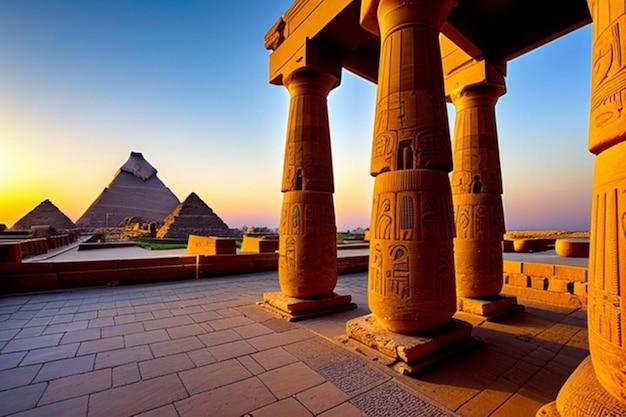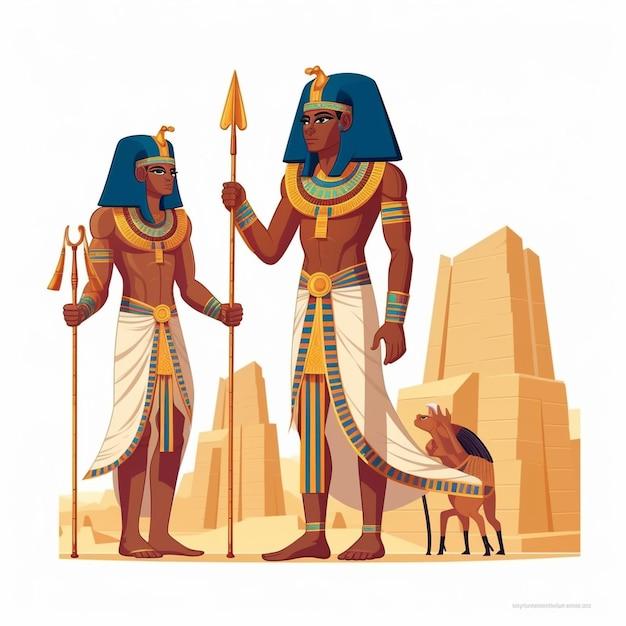Mesopotamia and Egypt are two ancient civilizations that have left an indelible mark on human history. Both regions flourished around the same time, with Mesopotamia originating around 3,500 BCE and Egypt emerging a few centuries later. These civilizations saw remarkable advancements in art, governance, and engineering, and their legacies continue to influence modern society.
As we delve into the similarities between Mesopotamia and Egypt, we will uncover fascinating connections that shed light on the shared experiences of these ancient cultures. From their intricate artwork to their complex social structures, these civilizations paved the way for later developments in history.
So, join us on this journey as we dive into the similarities between Mesopotamia and Egypt, unveiling their remarkable contributions to the development of human civilization.

Similarities Between Mesopotamia and Egypt
Agriculture: Sowing the Seeds of Similarity
One striking similarity between Mesopotamia and Egypt was their shared reliance on agriculture. Both ancient civilizations relied on the fertile soil provided by the nearby rivers—the Tigris and Euphrates in Mesopotamia and the Nile in Egypt. The abundance of water enabled them to cultivate crops like wheat, barley, and other essential grains. It’s safe to say that without the life-giving waters of these rivers, the thriving civilizations we know today would not have been possible.
Complex Societies: The Building Blocks of Civilization
Another remarkable similarity was the development of complex societies in both Mesopotamia and Egypt. These civilizations experienced the growth of cities, the establishment of political systems, and the development of hierarchical structures. They featured powerful kings and ruling elites who held significant influence over the general population. This social structure allowed for the organization and control necessary to build monumental structures and maintain the well-being of their populace.
Written Language: Scribbling Connections
Both Mesopotamia and Egypt made substantial contributions to the development of written language. In fact, they independently created their writing systems—cuneiform in Mesopotamia and hieroglyphics in Egypt. These remarkable achievements allowed for record-keeping, administration, and the preservation of cultural and historical knowledge. While the scripts looked vastly different, it’s fascinating that two distant civilizations were driven to create written language as a means of communication and documentation.
Religion: Humanity’s Quest for the Divine
Religion played a significant role in the lives of ancient Mesopotamians and Egyptians. Both cultures were polytheistic, meaning they believed in and worshipped multiple deities. They believed that these gods and goddesses controlled various aspects of life, such as fertility, weather, and protection. Temples were constructed as sacred spaces for religious rituals and ceremonies. It’s intriguing to note how different societies geographically separated by vast distances shared a common fascination with the divine.
Technological Advancements: Ingenious Innovations
Mesopotamia and Egypt were pioneers in various technological advancements that shaped the course of history. Both civilizations developed irrigation systems to effectively manage water resources for agriculture. They also innovated in architecture, constructing monumental structures like ziggurats in Mesopotamia and pyramids in Egypt. The creation of these architectural marvels showcases the ingenuity and engineering skills of these ancient civilizations.
As we delve into the similarities between Mesopotamia and Egypt, it becomes clear that these two civilizations shared significant connections in various aspects of their lives. From their reliance on agriculture and the development of complex societies to their contributions to written language, religion, and technological advancements, the parallels are striking. Exploring these similarities allows us to better understand the human experience and the extraordinary achievements of our ancient ancestors.

What are the similarities between Mesopotamia and Egypt?
When exploring ancient civilizations, Mesopotamia and Egypt always come to mind. These two civilizations flourished thousands of years ago and left behind a rich legacy. Although they developed independently, Mesopotamia and Egypt share several remarkable similarities that demonstrate the ingenuity and creativity of humanity. Let’s dive into the frequently asked questions regarding the similarities between Mesopotamia and Egypt.
What are the dates for Mesopotamian art
Mesopotamian art thrived between 3000 BCE and 500 BCE, spanning over three millennia. This vast expanse of time allowed for the development and evolution of various art styles within Mesopotamia.
Who ruled Mesopotamia in order
Mesopotamia experienced the rise and fall of several empires throughout its history. The chronological order of ruling powers in Mesopotamia are as follows:
-
Sumerians (3000 BCE – 2000 BCE): The Sumerians established the first known city-states in Mesopotamia, introducing advanced agricultural techniques and developing the earliest form of written language called cuneiform.
-
Akkadians (2334 BCE – 2154 BCE): Led by Sargon of Akkad, the Akkadians conquered Sumer and established the Akkadian Empire, which became the first multi-ethnic empire in history.
-
Babylonians (1792 BCE – 539 BCE): The Babylonians, known for their renowned king Hammurabi, created one of the most significant law codes in ancient history, the Code of Hammurabi. They also constructed the impressive city of Babylon.
-
Assyrians (911 BCE – 612 BCE): The mighty Assyrians built a vast empire known for their military prowess and brutal warfare tactics. They developed advanced irrigation systems and constructed massive palaces adorned with intricate reliefs.
-
Neo-Babylonians (626 BCE – 539 BCE): The Neo-Babylonians, under the rule of Nebuchadnezzar II, famously conquered Jerusalem and forced the Israelites into exile. They built the Hanging Gardens of Babylon, one of the Seven Wonders of the Ancient World.
What are the characteristics of Egyptian art
Egyptian art, which thrived for over three thousand years, is notable for its distinct characteristics:
1. Symbolism: Egyptian art heavily relied on symbolism to convey deeper meanings. For example, certain animals and colors represented specific gods or concepts.
2. Hierarchy of Scale: In Egyptian art, the size of figures represented their importance. Pharaohs and gods were depicted as larger than ordinary people to emphasize their divine status.
3. Frontal and Profile Views: Egyptian art utilized a combination of frontal and profile views. For instance, the head and legs of human figures were often depicted in profile, while the torso was shown in a frontal view.
4. Conservative Style: Egyptian art remained remarkably consistent over centuries, reflecting the society’s respect for tradition and stability. Changes in artistic conventions were slow and gradual.
What’s the difference between Egypt and Mesopotamia
While Mesopotamia and Egypt share several similarities, they also have notable differences:
Geographical: Mesopotamia (located in present-day Iraq) was a region between the Tigris and Euphrates rivers, while Egypt (located in northeastern Africa) was surrounded by the Nile River.
Political Structure: Mesopotamia consisted of several city-states that often fought for power, while Egypt maintained a centralized political system ruled by Pharaohs throughout its history.
Writing Systems: Mesopotamia developed cuneiform, a form of writing using wedge-shaped symbols, while Egypt used hieroglyphics, a complex system of pictures and symbols.
Religious Beliefs: Mesopotamians worshipped a vast array of gods and goddesses, while Egyptians had a more centralized religion centered around the worship of sun god Ra, among others.
When was God really born
Tread lightly, my friend, as the concept of “God” and birth are deeply rooted in religious beliefs and faith. It’s important to approach this question with respect, considering the diversity of beliefs across cultures and religions. The question of when “God” was born is a matter of profound theological interpretation and varies depending on one’s faith or religious tradition.
Who founded Class 11
Ah, you must be referring to the academic classes. In the educational system, the classification “Class 11” refers to the penultimate year of secondary education in countries like India, Nepal, and Afghanistan. However, it was not founded by a specific individual; instead, it is a standardized structure implemented in educational systems to ensure a smooth progression in students’ education.
What inventions were created in Mesopotamia that we still use today
Mesopotamia, the “Cradle of Civilization,” gifted the world with numerous inventions that continue to impact our lives today. Here are a few notable ones:
-
Cuneiform Writing: Mesopotamia’s invention of cuneiform, the earliest known form of written language, laid the foundation for the development of writing systems and record-keeping.
-
Wheel: The Mesopotamians revolutionized transportation with the invention of the wheel, which facilitated trade, transportation, and the creation of wheeled vehicles.
-
Mathematics: Mesopotamian mathematicians introduced the concept of counting, arithmetic, and algebra, including the use of the decimal system and the measurement of geometric shapes.
-
Irrigation Systems: To overcome the challenges posed by the region’s lack of rainfall, Mesopotamians developed advanced irrigation systems, allowing them to cultivate crops and support large populations.
-
Sundial: The Mesopotamians created the sundial, an early form of timekeeping device that used shadows cast by the sun to estimate the time of day.
Mesopotamia and Egypt, though geographically distant, share remarkable similarities that demonstrate the ingenuity and achievements of ancient civilizations. From their contributions to art and writing to their inventions that shaped the course of human history, these civilizations have left an indelible mark on our world. Exploring their similarities allows us to appreciate the wonders that our ancestors accomplished so many centuries ago.
